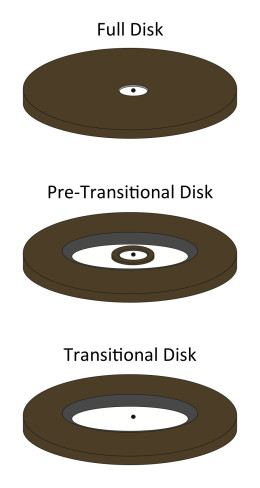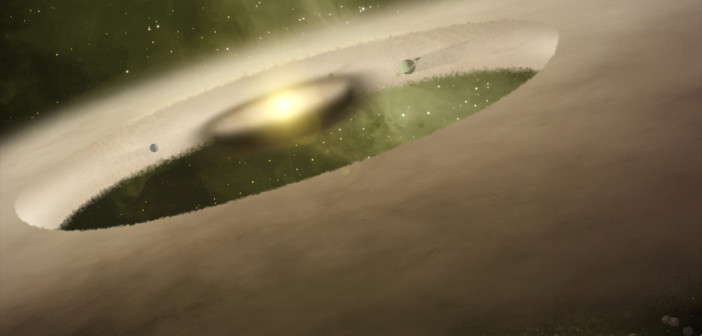The protoplanetary disk around DoAr 44 is fairly ordinary in most ways. But a recent study has found that this disk contains water vapor in its inner regions — the first such discovery for a disk of its type.
Drying Out Disks
DoAr 44 is a “transitional disk”: a type of protoplanetary disk that has been at least partially cleared of small dust grains in the inner regions of the disk. This process is thought to happen as a result of dynamical interactions with a protoplanet embedded in the disk; the planet clears out a gap as it orbits.

A schematic of the differences between a full protoplanetary disk, a pre-transitional disk, and a transitional disk. [Catherine Espaillat]
Enter the exception: DoAr 44. The disk in this system doesn’t have a fully cleared inner region, which labels it “pre-transitional”. It’s composed of an inner ring out to 2 AU, a cleared gap between 2 and 36 AU, and then the outer disk. What makes DoAr 44 unusual, however, is that it’s the only disk with a large inner gap known to harbor detectable quantities of water vapor. The authors of this study ask a key question: where is this water vapor located?
Unusual System
Led by Colette Salyk (NOAO and Vassar College), the authors examined the system using the Texas Echelon Cross Echelle Spectrograph, a visiting instrument on the Gemini North telescope. They discovered that the water vapor emission originates from about 0.3 AU — the inner disk region, where terrestrial-type planets may well be forming.
Both dust-shielding and water self-shielding seem to have protected this water vapor from the harsh radiation of the central star, and the authors model this shielding to place constraints on the composition of the disk’s inner regions. They conclude that DoAr 44 has maintained similar physical and chemical conditions to classical protoplanetary disks in its terrestrial-planet forming regions, in spite of having formed a large gap.
Why has DoAr 44 succeeded at maintaining its water vapor, unlike other transition disks? The authors propose that gas might be migrating across the gap in the disk, replenishing the inner disk from the outer. Future observations are planned to help better understand the overall architecture of the gap, as well as the implications of these detections for any possible planets embedded in the disk.
Citation
Colette Salyk et al 2015 ApJ 810 L24. doi:10.1088/2041-8205/810/2/L24


1 Comment
Pingback: Vapor de agua en un lugar inesperado « SEDA / LIADA